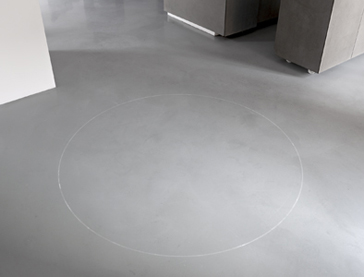
Born in 1940
Lives and works in Woodridge (NY, US)

1968
Ephemeral sculpture, circle of 183 cm in diameter drawn in chalk on a ground
Year of Purchase: 2011
Outlined in white chalk on the ground, the circle which makes up Ian Wilson’s Chalk Circle on the Floor (1968) appeals to us first of all by its rigorous, pure form and by the restricted economy of means used in its execution. In just a few lines, the instructions on how to make it describe a set of very simple steps requiring white chalk, a piece of string, and a nail. 1 183 cm in diameter and 1.25 cm thick, the line is traced directly in real space—the space of the spectator. It goes beyond the simple question of representation in order to extend to the immediate environment and define itself, not as a drawing sensu stricto, but as a piece of territory that one may, following the directions of the artist, bypass or traverse. Because its field of action, reality, is much more specific than a canvas, one could say that Ian Wilson’s work participates in minimalist artistic research conducted in the 1960s. One could even see in this round outline on the ground a rebuttal to the critique voiced by American art critic Michael Fried who, in a famous text published in 1967,2 attacked the “theatricality” of minimal art. Indeed, the work seems to delimit here a space of interaction that could be thought of as a “stage.”
Further, the insertion of drawing into space gives expression to the artist’s desire to challenge the very nature of the work of art. Chalk Circle on the Floor, exhibited for the first time at the Bykert Gallery in New York, is a certified, unlimited edition, which may be reproduced simultaneously at different locations. Potentially ubiquitous and multiplied, the circle on the ground first exists as a set of instructions. The impermanent nature of the work (which disappears at the end of each exhibition) affirms that its existence is primarily conceptual.
Ian Wilson’s work, Chalk Circle on the Floor bridges pictorial and sculptural production which, until 1968, had been associated with a certain type of representation, 3 and a purely conceptual practice which had emerged from formalist and materialist questions in order to become grounded only in language, in discussions. The chalk circle drawn on the floor is thus the last form created by the artist before he definitively abandoned all means of production other than “oral communication.”
A formal analysis of the drawing is thwarted by the regularity of its composition. Devoid of any artifice, removed from all types of elements invalidating language or making it more complex, the work exists only thanks to a perishable outline. Its circular shape, thus traced, represents an infinity without beginning or end, a form of circulation, an eternal renewal, a flux, that is related to that of time. 4 The revolution of the trace corresponds to the cycle of activation/deactivation of the work which takes place during every exhibition. By initiating a dialogue between a form and the process of its creation, the artist forcefully anchors abstraction in the tangible.
Guillaume Mansart
1 “Attach a white china chalk pencil to one end of a 3 foot long thin wire (the actual chalk center of the pencil would be 3/8 of an inch before sharpening). At the other end of the wire attach a nail. After hammering the nail into the floor, draw the circle around the nail, keeping the wire taut. Using the enclosed photo of the density of the white chalk, gradually build up the line until it is 1/2 an inch thick. When the circle is drawn, remove the nail from the floor. From time to time using the above described method, redraw any portions of the circle that have been smudged, keeping the circle as clean and as well defined as possible.” Instructions for the construction of the work, cited in Anne Rorimer, “Ian Wilson—The Object of Thought” in Ian Wilson, The Discussions, Van Abbemuseum, Eindhoven, MACBA, Barcelona and MAMCO, Geneva, 2008.
2 Michael Fried, “Art and Objecthood”, in Artforum 5, June 1967.
3 Ian Wilson’s paintings in the mid-1960s may be likened to non-objective art. They try to push the boundaries of abstraction to the point of paroxysm, thereby freeing it definitively from all relationship to objects or the materiality of the world.
4 It is worth noting that the first, purely non-material work by Ian Wilson was the word “time” which is also in FRAC Lorraine Collection.